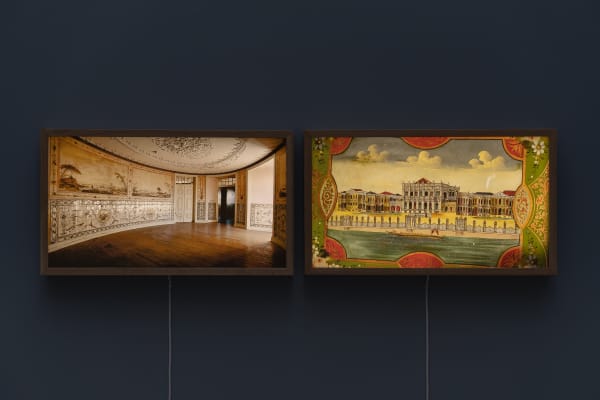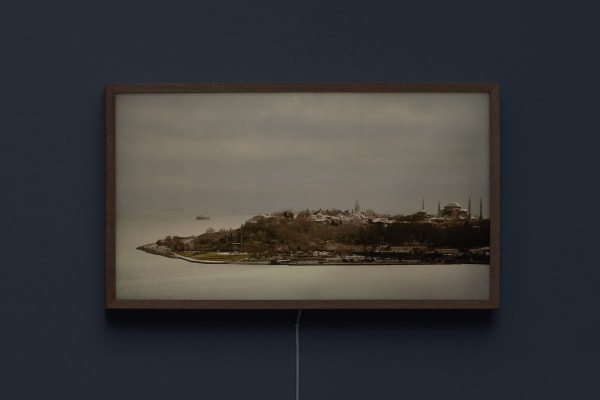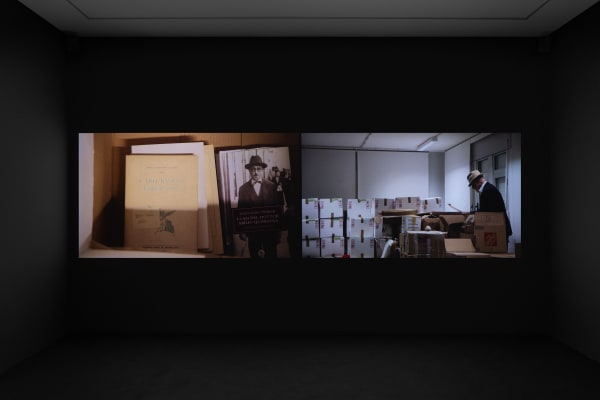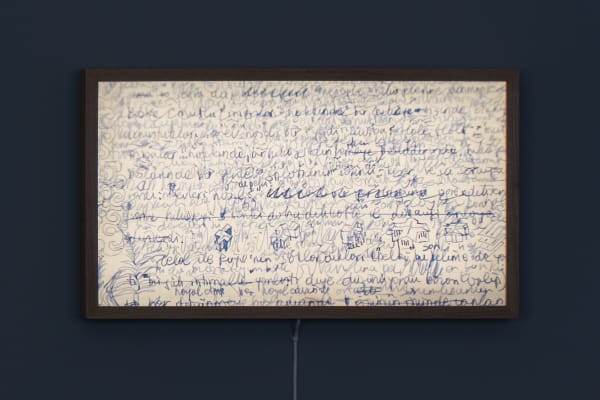Ali Kazma: Lisbon-Istanbul. Two Portraits on the Edge.: Curated by Maurizio Bortolotti
Ali Kazma ’s exhibition presents a view of Europe seen from its two geographical extremes through the lens of culture in a crucial historical moment for the continent.
This exhibition establishes a dialogue between Lisbon and Istanbul via two recent works by Kazma. Although located at opposite ends of Europe, the two cities share a similar condition. At the westernmost corner of Europe, Lisbon has historically been a gateway to the Americas. On the other hand, located at the easternmost part of the continent, Istanbul has been a hub for cultural and commercial exchanges with Asia.
In these two works, Ali Kazma explores the inner worlds of two major writers, Orhan Pamuk (Turkish), and now Lisbon-based Alberto Manguel (Argentinian). The videos look at the writers’ domestic lives and daily environments and bear witness to the complexity of European culture, especially in borderlands like Turkey and Portugal, where the infiltration and influences of other cultures are more visible. Given the changing political atmosphere in many of its countries, Europe, which seems inclined to closing its doors mentally and physically to others, is reminded of its own ideal which embraces the world’s complexity and richness. Adopting Pamuk’s and Manguel’s view of the world, the exhibition offers a model to rethink the European cultural approach.
The exhibition starts and ends with two videos about water: the waters of the Bosphorus, and those of the Tagus flowing into the Atlantic Ocean, which are integral to Istanbul and Lisbon’s landscapes. The liquid element of sea or ocean water powers both cities and offers a tangible representation of their conditions as margins and gateways; it represents a dynamic space of traveling and exchange. Through this natural element, culture acts as a portal through which visions of distant parts of the world connect. With these two videos, Ali Kazma’s narration finds a point of intersection between the two cities.
A constant state of uncertainty and expectancy defines this moment of significant global geopolitical change, governed by new economic strategies and technological innovations, and marked by a pandemic, wars, and massive population migrations. These two frontier cities, as it were, present a model for addressing the current situation and illustrate how complexity can enhance our experiences and assist us in navigating a deeply changing world.
Ali Kazma’s representation of the two writers’ lives embodies an idea of openness to the world as a paradigm at the roots of European culture. Both writers inhabit the continent’s peripheries. Their longing for hybridization between different worlds generates expansive visions of peoples’ ordinary lives. At the same time, they create points of connection with other continents.
The artist believes complexity is central to his ongoing exploration of today’s world. In the videos presented at the exhibition, he seeks to bridge the intricate landscape of the writers’ minds and their external environment. Throughout his career, he has developed a meta-narrative that connects human lives and environments with their representations. Kazma focuses on the watershed between reality and its image, the moment reality is poised to become representation, as seen in The Taxidermist. He creates a circular relationship between individual life and its depiction, where one gradually fades into the other. His narrative is not epic; it reflects our present existence, starting from exemplary lives or symbolic locations like the Svalbard Island Vault (in the video Safe), which houses all known plant seeds on Earth. Kazma’s filming methodology transcends all fictional narratives. He crafts a fluid and robust narrative that links distant points, which are the object of his inquiry. His narration explores the geographic relationship between living environments and cultural models in various world regions, from Europe to South America and Asia. The interplay between ordinary life and its representation, seen through cultural habits, is one of the central themes in Ali Kazma’s recent work.
Kazma's work is rooted in reality observation processes, which began many years ago in videos like Clock Master and Brain Surgery. He went on to develop this approach further, moving from the process of reality transformation to the exploration of cultural habits in specific life-environments, having investigated cultural models as points of connection between the symbolic and the real world across different locations worldwide.
Ali Kazma is part of a generation of video-makers who explored the narrow territory between cinema and contemporary art since the early 1990s. For artists like Doug Aitken, Matthew Barney, Pierre Huyghe, and Alfredo Jaar, it is not only about moving images; the installation in the exhibition space itself is part of their practice and enhances the meaning of the artworks.
Films are based on a plot; for this reason, they are often associated with literature. Artworks happen here and now in front of the spectator. This lineage of video-makers, including Ali Kazma, connects the essential features of the two genres, developing a new type of installation for videos, which contains a narration, even if often non-linear, and happens ‘here and now’ in the presence of the spectator who activates it. This means a video installation can only be experienced in its presence. In a way, we could say these artists spatialized the time of the narration through the video installation.
For this exhibition at Francisco Fino Gallery, Ali Kazma created a unique environment for viewing his videos. The environment is the ideal connection and the physical space of two European cities. Two videos about the waters of Lisbon and Istanbul open and close the exhibitive trajectory. The videos about Orhan Pamuk and Alberto Manguel are at the centre of the exhibition. On opposing walls, two colours symbolise the cities of Lisbon (yellow) and Istanbul (blue). An entire wall is dedicated to a series of stills from Ali Kazma’s videos in a combo made of lightboxes featuring a non-linear narration.
The exhibition is a site-specific installation that spatially represents a cultural dialogue between the two cities. It presents a common social imaginary evoked by Lisbon and Istanbul through the eyes of the two writers, whose similarities and differences reveal a web of shared roots.
Maurizio Bortolotti
-
 Ali KazmaSeries Lisbon - Istanbul I-II, 2025Light box in oak, printed on laminated vinyl38,5 x 66,6 x 6,5 cm (each)Edition of 3 plus 1 artist's proof
Ali KazmaSeries Lisbon - Istanbul I-II, 2025Light box in oak, printed on laminated vinyl38,5 x 66,6 x 6,5 cm (each)Edition of 3 plus 1 artist's proof -
 Ali KazmaSeries Lisbon - Istanbul III, 2025Light box in oak, printed on laminated vinyl82,5 x 55,5 x 6,5 cmEdition of 3 plus 1 artist's proof
Ali KazmaSeries Lisbon - Istanbul III, 2025Light box in oak, printed on laminated vinyl82,5 x 55,5 x 6,5 cmEdition of 3 plus 1 artist's proof -
 Ali KazmaSeries Lisbon - Istanbul IV-V, 2025Light box in oak, printed on laminated vinyl38,5 x 66,6 x 6,5 cm (each)Edition of 3 plus 1 artist's proof
Ali KazmaSeries Lisbon - Istanbul IV-V, 2025Light box in oak, printed on laminated vinyl38,5 x 66,6 x 6,5 cm (each)Edition of 3 plus 1 artist's proof -
 Ali KazmaSeries Lisbon - Istanbul VI, 2025Light box in oak, printed on laminated vinyl47,5 x 82,5 x 6,5 cmEdition of 3 plus 1 artist's proof
Ali KazmaSeries Lisbon - Istanbul VI, 2025Light box in oak, printed on laminated vinyl47,5 x 82,5 x 6,5 cmEdition of 3 plus 1 artist's proof -
 Ali KazmaSeries Lisbon - Istanbul VII, 2025Light box in oak, printed on laminated vinyl29,5 x 50,5 x 6,5 cmEdition of 3 plus 1 artist's proof
Ali KazmaSeries Lisbon - Istanbul VII, 2025Light box in oak, printed on laminated vinyl29,5 x 50,5 x 6,5 cmEdition of 3 plus 1 artist's proof -
 Ali KazmaSeries Lisbon - Istanbul VIII-IX, 2025Light box in oak, printed on laminated vinyl24,5 x 50,5 x 6,5 cm (each)
Ali KazmaSeries Lisbon - Istanbul VIII-IX, 2025Light box in oak, printed on laminated vinyl24,5 x 50,5 x 6,5 cm (each)
Edition of 3 plus 1 artist's proof -
 Ali KazmaSeries Lisbon - Istanbul X, 2025Light box in oak, printed on laminated vinyl82,5 x 55,5 x 6,5 cmEdition of 3 plus 1 artist's proof
Ali KazmaSeries Lisbon - Istanbul X, 2025Light box in oak, printed on laminated vinyl82,5 x 55,5 x 6,5 cmEdition of 3 plus 1 artist's proof -
 Ali KazmaSeries Lisbon - Istanbul XI-XII, 2025Light box in oak, printed on laminated vinyl38,5 x 66,6 x 6,5 cm (each)Edition of 3 plus 1 artist's proof
Ali KazmaSeries Lisbon - Istanbul XI-XII, 2025Light box in oak, printed on laminated vinyl38,5 x 66,6 x 6,5 cm (each)Edition of 3 plus 1 artist's proof -
 Ali KazmaSeries Lisbon - Istanbul XIII, 2025Light box in oak, printed on laminated vinyl29,5 x 50,5 x 6,5 cmEdition of 3 plus 1 artist's proof
Ali KazmaSeries Lisbon - Istanbul XIII, 2025Light box in oak, printed on laminated vinyl29,5 x 50,5 x 6,5 cmEdition of 3 plus 1 artist's proof -
 Ali KazmaAlberto in Lisbon, 2024Diptych Synchronized HD video with sound14´43´´
Ali KazmaAlberto in Lisbon, 2024Diptych Synchronized HD video with sound14´43´´
Filmed in Lisbon, Portugal and Mondion, France.Edition of 5 plus 2 artist's proofs -
 Ali KazmaSeries Lisbon - Istanbul XIV-XV, 2025Light box in oak, printed on laminated vinyl38,5 x 66,6 x 6,5 cm (each)Edition of 3 plus 1 artist's proof
Ali KazmaSeries Lisbon - Istanbul XIV-XV, 2025Light box in oak, printed on laminated vinyl38,5 x 66,6 x 6,5 cm (each)Edition of 3 plus 1 artist's proof -
 Ali KazmaSeries Lisbon - Istanbul XVI-XVII, 2025Light box in oak, printed on laminated vinyl29,5 x 50,5 x 6,5 cm (each)Edition of 3 plus 1 artist's proof
Ali KazmaSeries Lisbon - Istanbul XVI-XVII, 2025Light box in oak, printed on laminated vinyl29,5 x 50,5 x 6,5 cm (each)Edition of 3 plus 1 artist's proof -
 Ali KazmaSeries Lisbon - Istanbul XVIII, 2025Light box in oak, printed on laminated vinyl29,5 x 50,5 x 6,5 cmEdition of 3 plus 1 artist's proof
Ali KazmaSeries Lisbon - Istanbul XVIII, 2025Light box in oak, printed on laminated vinyl29,5 x 50,5 x 6,5 cmEdition of 3 plus 1 artist's proof -
 Ali KazmaSeries Lisbon - Istanbul XIX, 2025Light box in oak, printed on laminated vinyl82,5 x 55,5 x 6,5 cmEdition of 3 plus 1 artist's proof
Ali KazmaSeries Lisbon - Istanbul XIX, 2025Light box in oak, printed on laminated vinyl82,5 x 55,5 x 6,5 cmEdition of 3 plus 1 artist's proof -
 Ali KazmaSeries Lisbon - Istanbul XX, 2025Light box in oak, printed on laminated vinyl38,5 x 66,6 x 6,5 cmEdition of 3 plus 1 artist's proof
Ali KazmaSeries Lisbon - Istanbul XX, 2025Light box in oak, printed on laminated vinyl38,5 x 66,6 x 6,5 cmEdition of 3 plus 1 artist's proof -
 Ali KazmaSeries Lisbon - Istanbul XXI-XXII, 2025Light box in oak, printed on laminated vinyl29,5 x 50,5 x 6,5 cm (each)Edition of 3 plus 1 artist's proof
Ali KazmaSeries Lisbon - Istanbul XXI-XXII, 2025Light box in oak, printed on laminated vinyl29,5 x 50,5 x 6,5 cm (each)Edition of 3 plus 1 artist's proof -
 Ali KazmaBósforo-Tejo, 2025Diptych HD video with sound13'00''
Ali KazmaBósforo-Tejo, 2025Diptych HD video with sound13'00''
12'00''Edition of 2 plus 1 artist's proof -
 Ali KazmaA House of Ink, 2023Triptych HD video with sound
Ali KazmaA House of Ink, 2023Triptych HD video with sound
47´, 48´, 46
Filmed at Pamuk residence in Cihangir, IstanbulEdition of 5 plus 2 artist's proofs




















